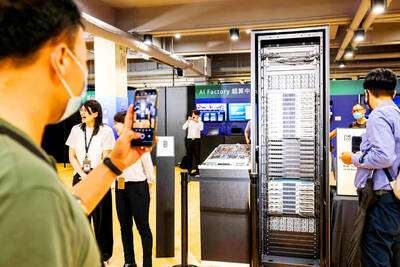Sharp Corp yesterday launched its flagship smartphone in Taiwan, marking the Japanese electronics maker’s official return to the local market after an absence of almost four years.
Sharp has been readjusting its operating strategy in Taiwan and other overseas markets after it reached an investment deal with Hon Hai Precision Industry Co (鴻海精密) in April.
Last month, the Japanese firm reached an agreement with Sampo Corp (聲寶) to close their retail joint venture in Taiwan in a bid to retrieve its rights to directly sell its home appliances to local consumers and lower its operating costs.

Photo: CNA
Hon Hai chairman Terry Gou (郭台銘) last month told shareholders that he plans to cut Sharp’s retail joint ventures in other countries in the upcoming months to improve the company’s operations.
In addition to Sharp’s white-goods business, Commtiva Technology Taiwan Ltd (康法科技), a close business partner of Hon Hai, is to assist Sharp in expanding its smartphone business’ reach in Taiwan and Southeast Asia.
Sharp’s Aquos P1, priced at NT$20,990 (US$648), features a 5.3-inch screen with Sharp’s indium-gallium-zinc-oxide display technology and a 22.6-megapixel rear camera, the Japanese company said.
Commitiva said that Taiwan has been chosen to be the first country for Sharp to introduce its annual flagship smartphones in the overseas market, adding that Commitiva would help the Japanese firm introduce its mid to high-end smartphones to Thailand, Singapore and Indonesia later this year.
“Given that Sharp’s smartphones have been absent from the Taiwan market for nearly four years, our priority is to reinforce its brand image as an innovative smartphone brand instead of pursuing handset shipment growth or market share in Taiwan,” Commtiva general manager Steven Yeh (葉順發) told reporters on the sidelines of the launch event.
Commenting on Sharp’s return to Taiwan’s handset market, HTC Corp (宏達電) North Asia president Jack Tong (董俊良) was quoted by the Chinese-language Apple Daily as saying that he expects to see limited effects from the moves because the Taiwanese smartphone market is already mature and saturated.
In related news, HTC yesterday posted a 26.74 percent annual decline in revenue and a 5.84 percent monthly decrease to NT$6.35 billion for last month, weaker than consensus estimates of NT$11.3 billion.
That brought the company’s combined revenue to NT$18.86 billion for last quarter, almost halved from NT$33 billion it made over the same period last year, according to a company filing with the Taiwan Stock Exchange.
Last quarter’s result represented sequential growth of 27 percent from NT$14.82 billion it reported in the first quarter.
HTC attributed the growth to its flagship smartphone launch and sales contribution from its Vive virtual reality headsets.
HTC’s accumulated revenue in the first half of the year plummeted 54.81 percent to NT$33.68 billion from a year earlier, the filing showed.

LIMITED IMPACT: Investor confidence was likely sustained by its relatively small exposure to the Chinese market, as only less advanced chips are made in Nanjing Taiwan Semiconductor Manufacturing Co (TSMC, 台積電) saw its stock price close steady yesterday in a sign that the loss of the validated end user (VEU) status for its Nanjing, China, fab should have a mild impact on the world’s biggest contract chipmaker financially and technologically. Media reports about the waiver loss sent TSMC down 1.29 percent during the early trading session yesterday, but the stock soon regained strength and ended at NT$1,160, unchanged from Tuesday. Investors’ confidence in TSMC was likely built on its relatively small exposure to the Chinese market, as Chinese customers contributed about 9 percent to TSMC’s revenue last

With this year’s Semicon Taiwan trade show set to kick off on Wednesday, market attention has turned to the mass production of advanced packaging technologies and capacity expansion in Taiwan and the US. With traditional scaling reaching physical limits, heterogeneous integration and packaging technologies have emerged as key solutions. Surging demand for artificial intelligence (AI), high-performance computing (HPC) and high-bandwidth memory (HBM) chips has put technologies such as chip-on-wafer-on-substrate (CoWoS), integrated fan-out (InFO), system on integrated chips (SoIC), 3D IC and fan-out panel-level packaging (FOPLP) at the center of semiconductor innovation, making them a major focus at this year’s trade show, according

DEBUT: The trade show is to feature 17 national pavilions, a new high for the event, including from Canada, Costa Rica, Lithuania, Sweden and Vietnam for the first time The Semicon Taiwan trade show, which opens on Wednesday, is expected to see a new high in the number of exhibitors and visitors from around the world, said its organizer, SEMI, which has described the annual event as the “Olympics of the semiconductor industry.” SEMI, which represents companies in the electronics manufacturing and design supply chain, and touts the annual exhibition as the most influential semiconductor trade show in the world, said more than 1,200 enterprises from 56 countries are to showcase their innovations across more than 4,100 booths, and that the event could attract 100,000 visitors. This year’s event features 17

Hon Hai Precision Industry Co (鴻海精密), which assembles servers for Nvidia Corp, yesterday said that revenue last month rose 10.61 percent year-on-year, driven by strong growth in cloud and networking products amid continued front-loading orders for artificial intelligence (AI) server racks. Consolidated revenue expanded to NT$606.51 billion (US$19.81 billion) last month from NT$548.31 billion a year earlier, marking the highest ever in August, the company said in a statement. On a monthly basis, revenue was down 1.2 percent from NT$613.86 billion. Hon Hai, which is also a major iPhone assembler, added that its electronic components division saw significant revenue growth last month, boosted